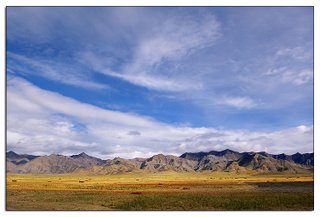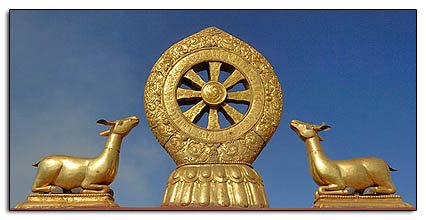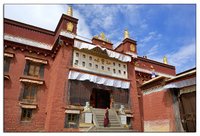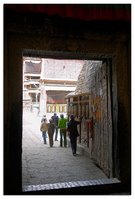Sakya Monastery and Shegar (New Tingri) (9/24)

Shortly after leave Shigatse, the scene outside the window changed quite a lot -- fewer and fewer green you could find, the colours were mostly dominated by yellow, brown and blue (sky).  This reminded me that I am on the way to the "real Tibet", or the Tibet in my imagination. It was Sunday today, however, there were groups of little kids walking along the Sino-Nepal Friendship Highway, with school bags on their back. The driver told me they were going to their schools in Sakya town, on foot! (geez, that is a long ways to walk! The distance could be easily over 20km). Usually students stay in school for a week -- go home on Friday, and come back to schools on Sunday. When those kids saw our jeep, they waved their hands, hoping to get a lift. Mr. Danzeng never stopped to pick them up, and I really felt guilty about that. However, what can we do -- our jeep simply can't hold that many people.
This reminded me that I am on the way to the "real Tibet", or the Tibet in my imagination. It was Sunday today, however, there were groups of little kids walking along the Sino-Nepal Friendship Highway, with school bags on their back. The driver told me they were going to their schools in Sakya town, on foot! (geez, that is a long ways to walk! The distance could be easily over 20km). Usually students stay in school for a week -- go home on Friday, and come back to schools on Sunday. When those kids saw our jeep, they waved their hands, hoping to get a lift. Mr. Danzeng never stopped to pick them up, and I really felt guilty about that. However, what can we do -- our jeep simply can't hold that many people.
Around noon we arrived Sakya (萨迦) town (altitude: 4336m), where the famous Sakya monastery locates. Sakyapa is one of the four main buddhism schools within Tibet (the other three are: Nyingma, Kagyu & Gelug). each with its own incomparable lineage of teachers and emphasis on particular practices. Sakya monastery is consisted of two monasteries: northern and southern monastery, on either side of the Trum-chu river. The northern monastery has been mostly destroyed, you can see its ruin sprawled across the hills. The newer (built about 200 years after the northern monastery) southern monastery is what people usually visit in these days.
 Sakya monastery is a pleasant place to visit. The monks over there are extremely friendly. Unlike other monasteries in Tibet, monks here LIKE being photographed! There are a group of young monks, when they saw me, with my (impressive) camera hanging on my neck, they rushed to me ask for taking photos of them. Here is the youngest one among them, putting his dinning bowl on his head. Well, I think this manner is sort of blasphemous for a religious man!
Sakya monastery is a pleasant place to visit. The monks over there are extremely friendly. Unlike other monasteries in Tibet, monks here LIKE being photographed! There are a group of young monks, when they saw me, with my (impressive) camera hanging on my neck, they rushed to me ask for taking photos of them. Here is the youngest one among them, putting his dinning bowl on his head. Well, I think this manner is sort of blasphemous for a religious man!We left Sakya around 3:30pm, continue the way to the next destination: Shegar (协格尔,新定日). The weather wasn't looking good after Lhatse(拉孜) -- in Sakya, I could still manage to find some sunshine and blue sky, but here the sky turned gray and overcast. I am very concerned about the weather in Mt Everest tomorrow!
Due to some road-work, our jeep (and many others) had to stop and waited for about two hours near Katso-la (加错拉) pass, at altitude of 5000+m. Not fun!
 We arrived Shegar after 7pm. This is a small town with nothing really interesting.
We arrived Shegar after 7pm. This is a small town with nothing really interesting.Next Story: Mt Qomolangma (Mt Everest).
Previous Story: Shigatse







No comments:
Post a Comment